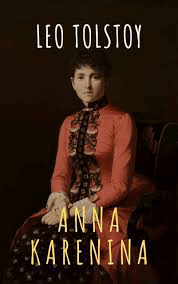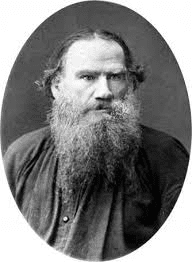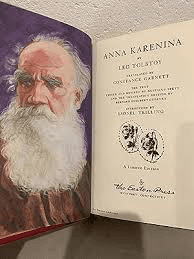Introduction: Overview of Leo Tolstoy and his significance in literature

Source: Storytel
Anna Karenina Tolstoy’s Magnum Opus remains highly relevant even in modern times. Leo Tolstoy, who was one of the most well-known authors of the 19th century, has left a lasting impression on the worldwide literary community.
Born on September 9, 1828, in Yasnaya Polyana, Russia, Tolstoy came from a very noble family, He had a profound impact of the lives of the peasants which later affect his literary works very clearly,
Tolstoy was the first to explore the depths of the dynamics of the society as well as the human mind. His books are praised for their He had a deep philosophical understanding of character development are done and sophisticated storylines are created.
“War and Peace” and “Anna Karenina,” are among his most well-known compositions. These are regarded worldwide. as masterpieces of the classical literature.
“War and Peace,” is a vast epic which was released between 1865 and 1869. It tells the story of the lives of Russian aristocracy during the Napoleonic Wars.
It has given an accurate picture of historical events of that period. Concepts like fate and freedom and the nature of conflict and peace have been written in a very interesting way.
Anna Karenina Tolstoy’s Magnum Opus was published between 1873 and 1877 in serial form. It is a living story about love, infidelity, and social expectations in 19th-century Russian society.
In Anna Karenina Tolstoy’s Magnum Opus, Tolstoy’ has done a superb examination of moral quandaries. Naturally, It has captured the attention of people all around the world.
“Anna Karenina” as Tolstoy’s masterpiece:

Source: Medium
“Anna Karenina” thrills the readers with its in-depth examination of social conventions, and human emotions.
This work is still regarded as a timeless masterpiece that appeals to readers of all ages.
Anna Karenina Tolstoy’s Magnum Opus is about Anna who is a married aristocrat. She defies social mores and time periods and goes on having a passionate affair with the charming Count Vronsky.
In this great work, Tolstoy depicts the complexity of love, desire, and duty against the backdrop of 19th-century Russia.
“Anna Karenina” is really a classic because it is deeply empathetic and unquestionably human..
From the troubled Anna to the idealistic landowner Levin, every character has its own unique depth and subtlety.
Setting the scene: Russia in the 19th century
Setting the scene in Anna Karenina Tolstoy’s Magnum Opus, Russia in the 19th century emerges as a character in its own right, deeply influencing the lives and choices of the novel’s protagonists.
Against the backdrop of Tsarist Russia, societal norms and class distinctions reign supreme, shaping the behavior and expectations of individuals across all strata of society.
The vast expanse of the Russian countryside, with its sprawling estates and harsh winters, serves as a stark contrast to the opulent salons of St. Petersburg and Moscow, highlighting the disparities between urban and rural life.
Moreover, the political upheaval of the era, marked by the abolition of serfdom and the rise of revolutionary fervor, adds an undercurrent of tension and uncertainty to the narrative.
Through his richly detailed portrayal of 19th-century Russia, Tolstoy invites readers to immerse themselves in a world that is both familiar and foreign, providing a nuanced understanding of the forces that shape the characters’ destinies.

Tolstoy’s insights on Russian culture
In Anna Karenina, Tolstoy makes astute insights about Russian society. Tolstoy’s Magnum Opus demonstrates a deep comprehension of its inconsistencies and complexity.
Tolstoy reveals the severe class divisions and ingrained aristocratic privilege that characterize Russian society’s hierarchical structure through his characters’ interactions.
He examines the hypocrisy of a culture that claims to respect traditional values but keeps secrets and engages in scandalous relationships.
In addition, Tolstoy explores the inner lives of the Russian nobility, exposing their existential conflicts, wants, and fears behind a façade of decorum and polish. From the opulent ballrooms of the nobility to the modest peasant homes,
Sociopolitical backdrop and its influence on the narrative
 Anna Karenina Tolstoy’s Magnum Opus
Anna Karenina Tolstoy’s Magnum Opus
Source: AbeBooks
Sociopolitical backdrop and its influence on the narrative
The story of Anna Karenina Tolstoy’s Magnum Opus is significantly influenced by the geopolitical climate of 19th-century Russia.
With the backdrop of a country in turmoil due to the fallout from the emancipation of the serfs and simmering revolutionary feelings, Tolstoy crafts a story that captures the tensions and uncertainties of the time.
The characters’ difficulties are shaped by the strict social structure and traditional norms of Russian culture, which operate as a furnace, ultimately determining their fates.
Furthermore, the novel’s recurring themes of morality, responsibility, and individual freedom are highlighted by the political turmoil of the day. By means of his sophisticated investigation of the sociopolitical terrain,
Plot Summary: Overview of the main plotlines and characters: Anna Karenina Tolstoy’s Magnum Opus
Anna Karenina Tolstoy’s Magnum Opus is filled with a rich tapestry of interconnected plotlines and compelling characters.
Anna is a passionate and complex woman trapped in a loveless marriage. She has an illicit affair with the dashing Count Vronsky .
This leads to a tragic unraveling of her life. Alongside Anna, we also comes across the story of Konstantin Levin who is a landowner.
Levin grapples with existential questions and searches for meaning in life. Levin’s journey serves as a counterpoint to Anna’s tumultuous romance which offers insights into themes of faith, work, and family.
There are a host of secondary characters surrounding these central figures. Each of them has one’s own desires, struggles, and moral dilemmas.
Tolstoy paints a vivid portrait of Russian society, from the noble Karenin to the innocent Kitty and the rakish Vronsky.
This really captures the complexities of human relationships. We also notice the collision of personal desires with societal expectations in this great piece of work.
Click to Buy/Check-

Key themes: love, societal norms, and morality
Anna Karenina Tolstoy’s Magnum Opus has key themes of love, societal norms, and morality, Here,
Love is portrayed in its myriad forms which serves as a driving force as well as a source of anguish for the characters.
Anna and Vronsky’s passionate affair challenges societal conventions and moral boundaries, which illustrates the power of love.
Meanwhile, Levin’s search for genuine love and connection leads him on a journey of self-discovery. This culminates in the form of embracing the family life and spiritual fulfillment.
The novel explores the tensions between individual desires and collective expectations against the backdrop of rigid societal norms.
The confines of marriage and class are exposed by Anna’s rebellion against the hypocrisy of a society that prizes appearances over authenticity,
Levin’s struggles with societal pressures highlight the quest for personal integrity amidst societal conformity.
In Anna Karenina Tolstoy’s Magnum Opus, morality is depicted as a complex and subjective concept,as the characters grapple with the consequencs of their actions. We also witness the conflicting demands of duty and desire.
Anna’s tragic fate underscores the moral ambiguity of human behavior and the devastating consequences of moral transgression.
“Anna Karenina” offers a profound meditation on the human condition, inviting readers to ponder the nature of love by exploring these themes.
The tragic ending and its implications
The tragic ending of “Anna Karenina” casts a shadow over the entire narrative. This leaves a profound impact on both the characters and the readers.
Anna’s death occurs by suicide, as she throws herself under a train. This serves as the culmination of her downward spiral. Definitely, it was driven by societal condemnation, guilt, and despair.
Her tragic demise throws light on the consequences of her defiance of societal norms and moral codes. This also highlights the destructive power of passion unrestrained by reason.
Moreover, Anna’s death reverberates beyond her individual fate and produces an echo of the broader themes of the novel.
It serves as a reminder of the limitations imposed by society on individual freedom and expression. It also draws our attention towards the price paid for deviating from prescribed roles and expectations.
Anna’s tragic end has a reflection of the nature of happiness and fulfillment which raises many questions to a world fraught with moral ambiguity and social constraints.
Anna Karenina: Complexities of her character and motivations
Anna Karenina is the central character of this masterpiece. She is a woman of profound complexity, Her character and motivations are explained very nicely throughout the story.
Anna’s inner turmoil becomes increasingly evident as the story progresses. However, she is Initially introduced as a woman of grace and charm,
The reasons for her motivations come out of her deep yearning for love and fulfillment. They are also driven by societal expectations and pressures.
Anna seeks solace and passion in her affair with Vronsky as she is trapped in a loveless marriage to Karenin. But her pursuit of happiness leads her to a path of self-destruction.
Anna is plagued by insecurities and contradictions despite her intelligence and sophistication, She is torn between her desire for freedom and her fear of societal condemnation.
A complex interplay of emotions—love, guilt, shame, and longing—make her a deeply human and relatable character.
Other central characters: Levin, Kitty, Vronsky, etc.
In addition to Anna Karenina, there is a rich array of central characters, each having one’s own distinctive traits, motivations, and story arcs.
Levin, who is a landowner and philosophical thinker, serves as a foil to Anna’s passionate turmoil. He grapples with questions of faith, work, and the pursuit of happiness and embarks on a journey of self-discovery.
His courtship of Kitty, Anna’s sister-in-law, forms a central subplot in the novel.
Kitty is initially infatuated with Vronsky. But she undergoes a profound evolution later on as she comes to understand the true nature of love and maturity.
She grows from a naïve young girl into a resilient and mature woman which gives a contrast to Anna’s tragic descent.
Count Alexei Vronsky, is a dashing and charismatic officer whose passion for Anna sets off a chain of events which keep its echo throughout the novel.
His character has the allure of forbidden love and the consequences of yielding to desire. He always grapples with the guilt and responsibility of his role in Anna’s downfall.
Tolstoy masterfully interweaves the lives of these central characters throughout the novel. He explores the themes of love, morality, and the pursuit of happiness in a society which is marked by rigid social norms and personal ambitions.
Character development and relationships: Anna Karenina Tolstoy’s Magnum Opus
Leo Tolstoy’s exploration of the human condition and social dynamics is very clear in Anna Karenina Tolstoy’s Magnum Opus .
Throughout the novel, Tolstoy meticulously traces the evolution of each character, in which he illuminates their inner struggles, growth, and relationships with others.
Konstantin Levin is one of the most striking examples of character development. His journey from existential doubt to personal fulfillment serves as a counterpoint to Anna’s tragic end.
Levin has introspective nature and his philosophical inquiries lead him on a path of self-discovery.
He grapples with questions of faith, work, and love. His own emotional and spiritual growth is clearly reflected in his relationship with Kitty (from initial infatuation to mature companionship).
We notice profound character development of Anna Karenina, although in a tragic direction. Initially, she appears to be a glamorous and confident woman. But, her inner turmoil and dissatisfaction with marriage makes her fall into a passionate affair with Vronsky.
We can clearly see the complex and multifaceted relationships between the characters of Anna Karenina Tolstoy’s Magnum Opus Sense of passion and guilt in Anna’s affair with Vronsky, affect the lives of those around them. This really exposes the fragility of human bonds.
Through the character development and relationships, Tolstoy makes the readers ponder the intricacies and the complexities of human nature.
Critique of societal norms and expectations
Social norms and expectations prevalent in 19th-century Russian society are very powerfully analyzed in Anna Karenina Tolstoy’s Magnum Opus.
In this masterpiece, Leo Tolstoy clearly exposes the rigidity of these norms, and he also reveals how they negatively affect the individual freedom and authenticity.
Tolstoy highlights the negative effects of social conventions on personal happiness through the characters like Anna (who rebels against the constraints of her loveless marriage and society’s expectations.
Moral dilemmas and consequences of choices
Anna Karenina Tolstoy’s Magnum Opus explores moral dilemmas and consequences of choices, highlighting the complexities of human behavior.
The characters, Anna and Levin, face ethical dilemmas balancing duties, desires, and societal expectations, leading to tragic consequences.
Tolstoy emphasizes the importance of moral introspection and ethical decision-making in navigating these dilemmas.
Relevance of these themes in contemporary society
Anna Karenina Tolstoy’s Magnum Opus explores themes of love, societal norms, moral dilemmas, and the consequences of our choices.
It critiques societal norms, reminds us to question the status quo, and reflects the complexities of modern relationships and the pursuit of happiness.
The moral dilemmas faced by characters prompt reflection on our actions’ implications on ourselves and society.
Tolstoy’s narrative techniques and storytelling prowess: Anna Karenina Tolstoy’s Magnum Opus
Tolstoy’s narrative techniques and storytelling prowess in Anna Karenina Tolstoy’s Magnum Opus are renowned for their depth and complexity.
Through intricate character development, vivid imagery, and masterful pacing, Tolstoy immerses readers in the rich tapestry of 19th-century Russian society.
His use of omniscient narration allows for a panoramic view of the characters’ inner lives and external conflicts, enhancing the novel’s realism and emotional impact.
Tolstoy’s attention to detail, from the lush descriptions of Russian landscapes to the nuanced portrayal of social interactions, creates a world that feels vibrant and alive.
Through these techniques, Tolstoy crafts a narrative that is both timeless and profoundly captivating.
Use of symbolism, foreshadowing, and imagery
The Magnum Opus by Anna Karenina Tolstoy skillfully and precisely combines symbolism, foreshadowing, and imagery to enhance the story with multiple levels of significance and complexity.
The novel’s narrative coherence and thematic resonance are enhanced by symbolism, which includes the recurrent motif of trains as a representation of fate and inevitability.
With its subtle hints to the characters’ futures, foreshadowing heightens the tension and suspense as the story develops.
Impact of Tolstoy’s writing style on the reader’s experience: Anna Karenina Tolstoy’s Magnum Opus
Magnum Opus by Anna Karenina Tolstoy has a great effect on the reader’s experience by engrossing them in a richly detailed world of striking imagery and profound reflection.
His complex writing style and omniscient narrator provide readers with unmatched insight into the thoughts and feelings of the characters, encouraging empathy and comprehension.
From the detailed depictions of Russian landscapes to the smallest details of social interactions, Tolstoy’s attention to detail provides an immersive experience that lingers long beyond the last page.
His philosophical reflections on morality, love, and the human condition also elicit contemplation and thought, which enhances the reader’s intellectual interaction with the work.
All things considered, Tolstoy’s literary approach turns “Anna Karenina” from a simple book into a profoundly moving read.
Anna Karenina’s enduring legacy in literature: Anna Karenina Tolstoy’s Magnum Opus
Magnum Opus by Anna Karenina Tolstoy is still regarded as a timeless work of literature that has a profound impact on both writers and readers.
Beyond its 19th-century Russian setting, Tolstoy’s examination of love, morality, and social conventions resonates with people of all ages and backgrounds.
Readers are captivated by the characters’ intricacy and the subjects’ profundity, which yields fresh perspectives with every reading.
In addition, “Anna Karenina” has spawned innumerable retellings, homages, and adaptations, solidifying its place in literature.
Its capacity to arouse feelings, spark debate, and shed unmatched depth and insight on the human condition accounts for its enduring impact.
Why “Anna Karenina” remains a relevant and compelling read in the 21st century: Anna Karenina Tolstoy’s Magnum Opus
Because of its deep insight of the human mind and its eternal examination of universal issues, Anna Karenina Tolstoy’s Magnum Opus is still relevant and alluring in the twenty-first century.
Tolstoy’s observations on morals, love, and society expectations speak to readers today who are facing same problems, even though the novel is set in 19th-century Russia.
In addition, readers can contemplate their own lives and decisions by looking into the mirror provided by the characters’ moral quandaries and complexity.
Furthermore, the novel’s complex prose, intellectual depth, and rich narrative tapestry support its lasting influence, making it an engrossing read that appeals to readers of all ages and backgrounds.
Conclusion: Anna Karenina Tolstoy’s Magnum Opus
To sum up, Anna Karenina Tolstoy’s Magnum Opus is a timeless work that cuts over cultural and historical barriers and provides readers with a deep understanding of the complexity of the human condition.
Leo Tolstoy’s masterwork enthralls and moves readers even in the twenty-first century with its complex characters, fascinating story, and everlasting ideas.
Its capacity to arouse feelings, stir thought, and start discussions about morality, love, and social conventions accounts for its ongoing importance.
Reading Anna Karenina Tolstoy’s Magnum Opus serves as a reminder of the literature’s eternal ability to shed light on the depths of human experience and to provide comfort and understanding in a world that is constantly changing.
Also Read-
https://topupdates.info/best-elastane-stretch-mid-waist-shorties/
https://topupdates.info/womens-plus-size-chest-print-t-shirt/
https://topupdates.info/best-indian-shows-on-netflix/
https://topupdates.info/it-starts-with-us/
https://topupdates.info/best-rbi-grade-b-books-2024/

5 thoughts on “Anna Karenina Tolstoy’s Magnum Opus: Wonderful Reading (2024)”